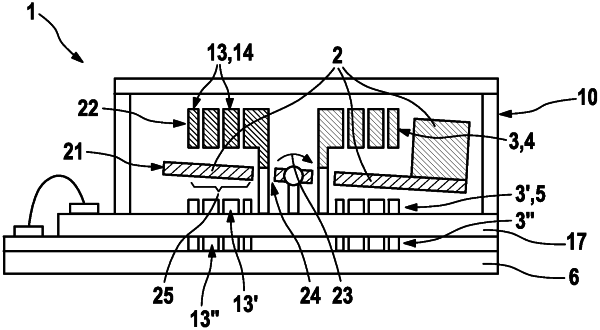| CPC G01P 1/006 (2013.01) [G01P 15/08 (2013.01); G01P 2015/0862 (2013.01)] | 15 Claims |

|
1. A method for temperature compensation of a microelectromechanical sensor, the sensor having a movable structure configured to measure a physical stimulus, the method comprising:
producing, in a balancing step, a temperature gradient by at least one thermal element so that a first and second partial region of the sensor are at different temperatures, wherein a first temperature is determined at a first temperature measurement point arranged in the first partial region and a second temperature is determined at a second temperature measurement point arranged in the second partial region, and wherein a deflection of the movable structure produced by the temperature gradient is measured, so as to provide a measured deflection, and a compensation value is determined dependent on the first and second temperature and the deflection;
measuring, in a measurement step, the physical stimulus using the deflection of the movable structure, wherein a third temperature is determined at the first temperature measurement point and a fourth temperature is determined at the second temperature measurement point; and
ascertaining, in a compensation step, a measured value of the physical stimulus dependent on the measured deflection, the third and fourth temperatures, and the compensation value;
wherein the deflection caused by the temperature gradient is measured only when a stable temperature profile is obtained, wherein the measurement of the deflection takes place with a time delay relative to activation of the thermal element, and wherein the first and second temperature measurement points are monitored and the measurement of the deflection takes place only when the first and second temperatures have assumed a stable value, and
wherein to separate the deflection brought about by the physical stimulus from a thermal influence of the temperature gradient, the third and fourth temperatures in the two measurement points are determined simultaneously together with the deflection, and wherein together with the third and fourth temperatures, the corrected measured value of the physical stimulus are ascertained from the compensation value, which quantifies the thermal influence of the temperature gradient.
|